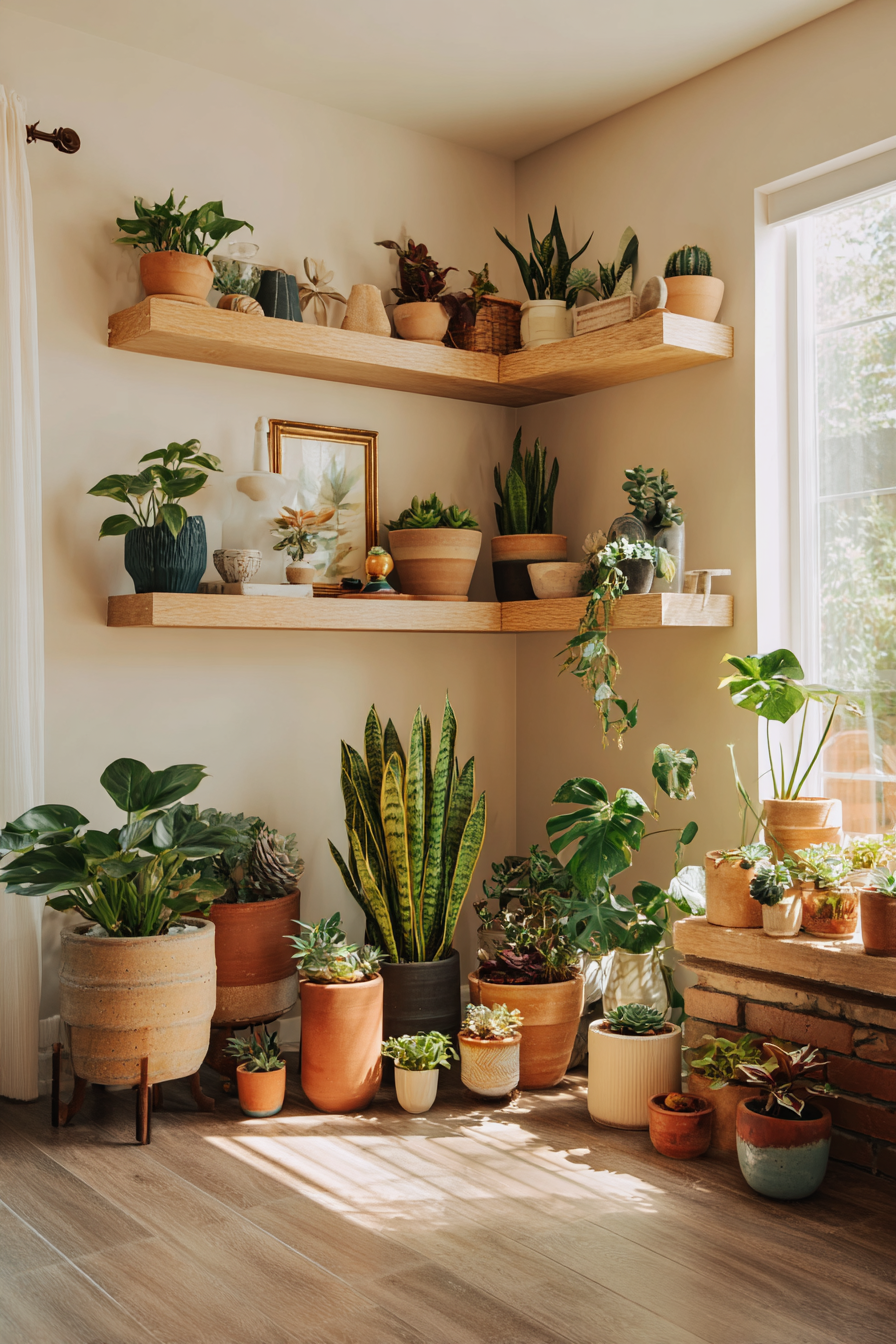There’s something magical about walking into a living room that feels like a warm embrace—where every corner whispers comfort and every surface invites you to settle in and stay awhile. I’ve discovered that earth tones are the secret ingredient to creating this kind of sanctuary in your own home. These grounding, natural hues have become my go-to palette for transforming any living space into a cozy retreat that feels both sophisticated and welcoming.
Earth tones aren’t just a design trend; they’re a timeless approach to decorating that connects us to the natural world around us. From rich terracotta and warm ochre to soft sage greens and deep chocolate browns, these colors create an instant sense of calm and stability. I’ve seen how incorporating these warm, organic shades can completely transform the energy of a room, making it feel more grounded, peaceful, and authentically you.
What I love most about decorating with earth tones is their incredible versatility. Whether you’re drawn to a rustic cottagecore aesthetic, prefer modern minimalism with natural touches, or want to create an eclectic bohemian vibe, earth tones provide the perfect foundation. They work beautifully with both vintage and contemporary pieces, making them ideal for anyone looking to refresh their space without starting from scratch.
In this guide, I’ll share ten of my favorite ways to incorporate earth tones into your living room, from small accent pieces that make a big impact to bold design choices that completely reimagine your space. Each approach is designed to help you create a living room that feels warm, inviting, and perfectly suited to your lifestyle.
1. Layer Rich Textiles for Instant Warmth
Creating depth and coziness in your living room starts with thoughtful textile layering in beautiful earth tones. I love mixing textures like chunky knit throws in warm camel, linen cushions in sage green, and wool rugs in deep terracotta. The key is to vary your textures while maintaining that earthy color palette—think raw silk, jute, cotton canvas, and soft cashmere. Start with a neutral base like a cream or mushroom-colored sofa, then add layers of earth-toned pillows, throws, and blankets. Designer tip: Aim for at least three different textures in each seating area to create visual interest without overwhelming the space. This approach instantly makes your living room feel more inviting and lived-in.
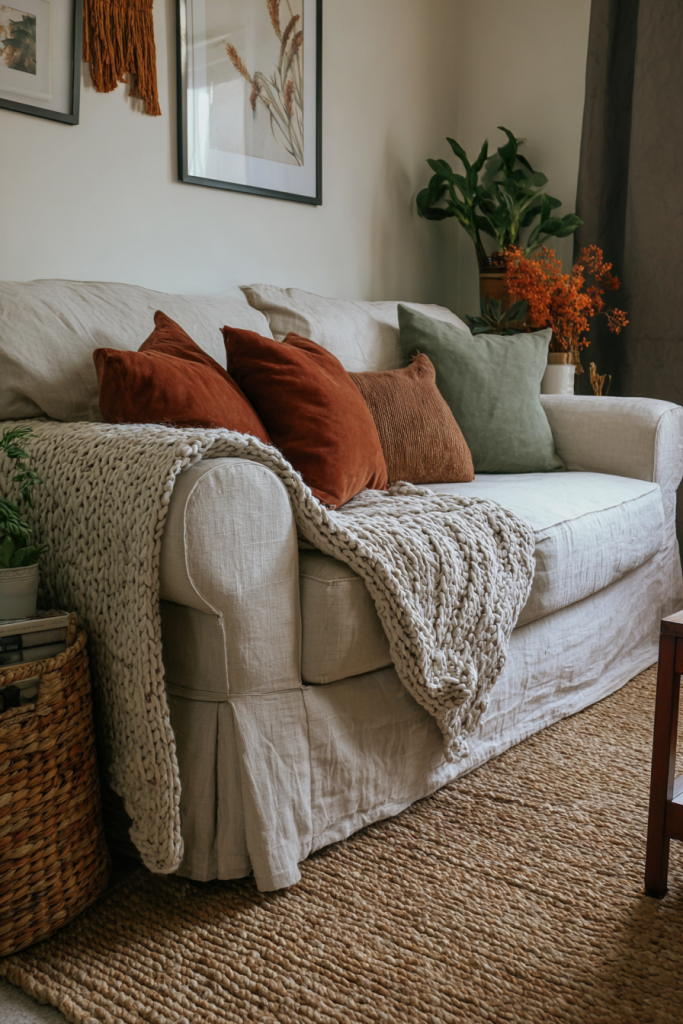
2. Embrace Natural Wood Furniture Elements
Nothing grounds a living room quite like beautiful natural wood furniture in rich, warm tones. I’m particularly drawn to pieces in walnut, oak, and cherry that showcase the wood’s natural grain and character. A live-edge coffee table, reclaimed wood media console, or handcrafted side tables can serve as stunning focal points while adding that essential earthy foundation. The beauty of wood furniture is how it ages and develops character over time, becoming more beautiful with each passing year. Mix different wood tones confidently—contrary to old design rules, combining various wooden elements creates depth and authenticity. Consider a warm walnut dining table paired with lighter oak shelving, or mix vintage teak pieces with modern maple accents for an eclectic, collected-over-time feel.
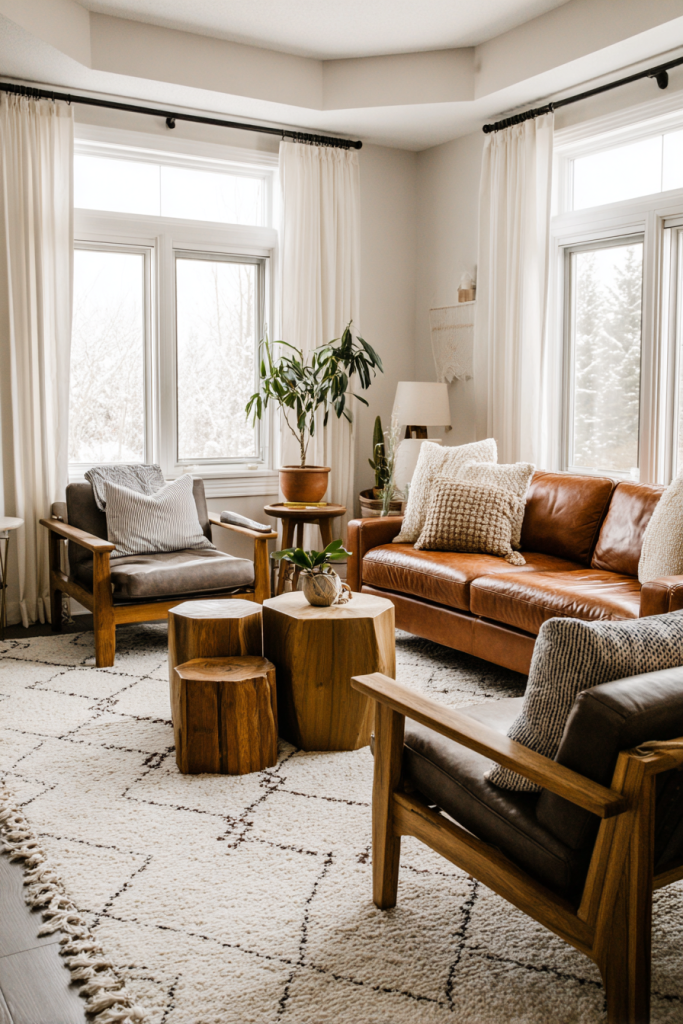
3. Create Warmth with Earth-Toned Wall Treatments
Your walls are the largest canvas in your living room, making them perfect for embracing earth tones in a big way. I’ve found that warm paint colors like mushroom gray, soft clay, or sage green create an immediately cozy atmosphere. But don’t stop at paint—consider textured wallpaper in natural grasscloth, wood paneling in warm honey tones, or even a stunning accent wall in natural stone or brick. These treatments add both color and texture, creating visual interest that flat paint simply can’t achieve. For renters or those hesitant about permanent changes, large-scale artwork or removable wallpaper in earth tones can achieve similar impact. The key is choosing treatments that feel organic and natural rather than overly polished or artificial.
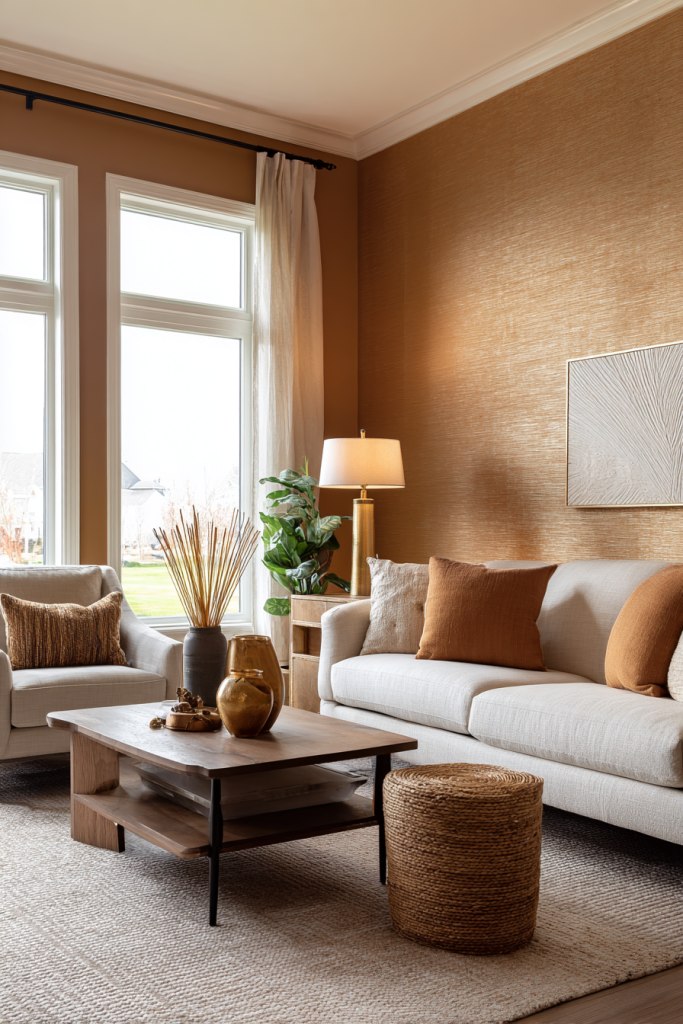
4. Style with Earth-Toned Pottery and Ceramics
Handcrafted pottery and ceramics in earth tones bring both function and artistry to your living room while celebrating natural materials and craftsmanship. I love collecting pieces in warm terracotta, deep ochre, and soft sage—think large floor vases, sculptural bowls, and unique planters that double as art pieces. These organic shapes and natural glazes add visual weight and interest to your space while maintaining that connection to the earth. Group pieces in odd numbers on coffee tables, floating shelves, or mantels for maximum impact. Don’t be afraid to mix different pottery styles and glazes within your earth-tone palette—the slight variations in color and texture create a more authentic, collected feel. Consider supporting local artisans whose work reflects your personal style and values.
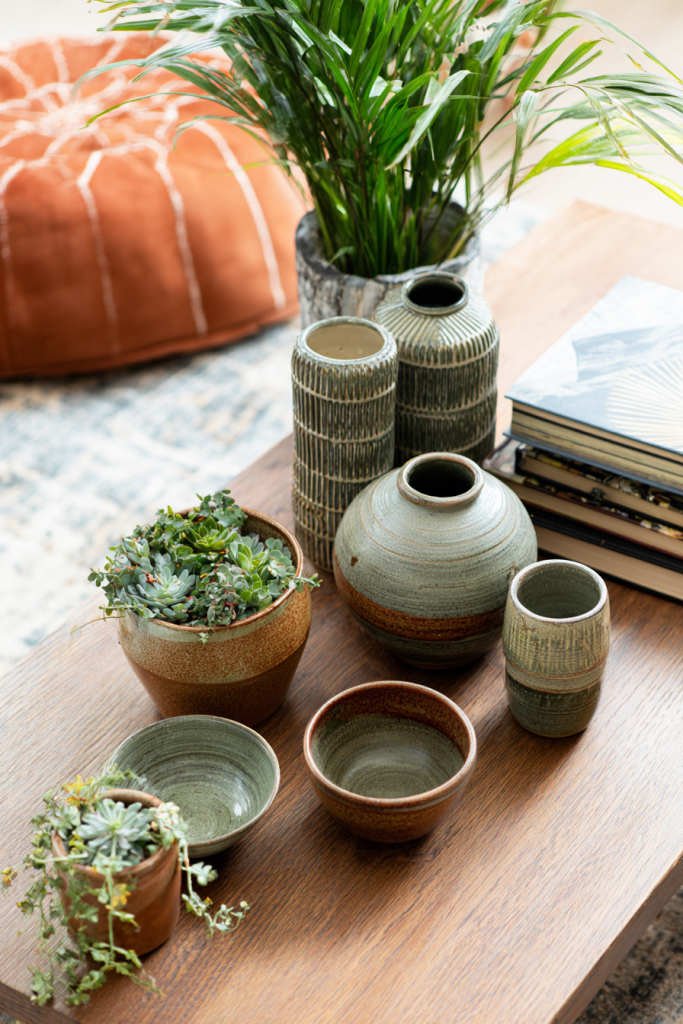
5. Integrate Living Plants as Natural Accents
Plants are perhaps the most authentic way to bring earth tones into your living room, offering both color and life to your space. I’m particularly fond of plants with interesting foliage colors—dusty miller with its silvery-green leaves, burgundy rubber trees, or olive trees with their distinctive gray-green color. Large floor plants like fiddle leaf figs or snake plants in beautiful terra cotta or ceramic planters create instant focal points while purifying your air. For smaller spaces, create plant groupings on side tables or floating shelves using plants with varying heights and textures. The key is choosing planters that complement your earth-tone palette—think natural clay, woven baskets, or ceramic pots in warm glazes. Plants bring that essential life force that makes a house feel like a home.
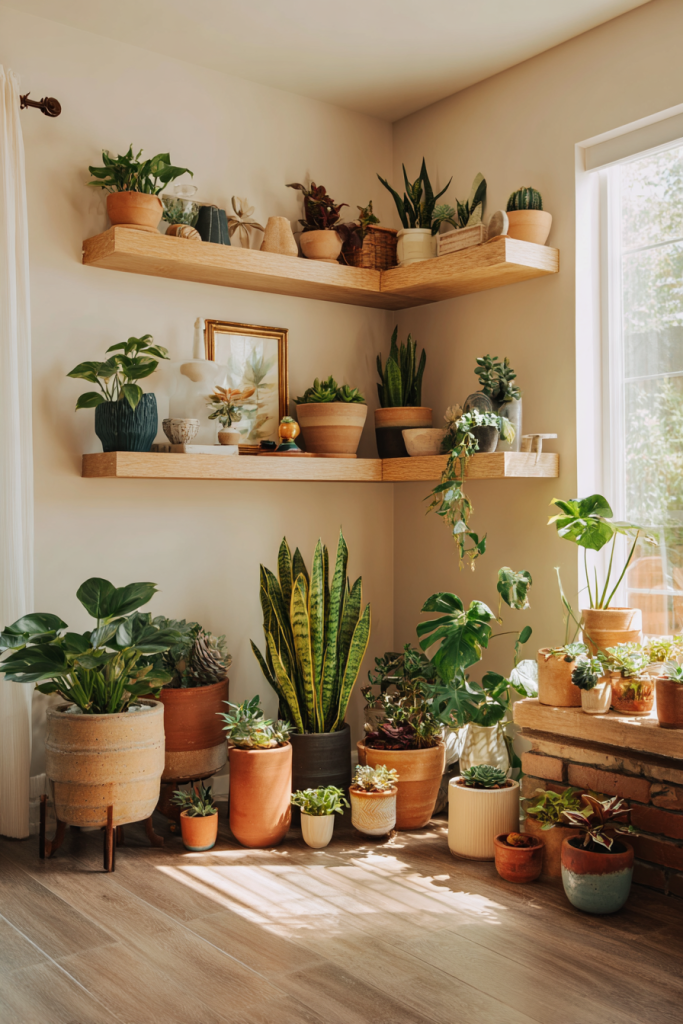
6. Choose Lighting That Enhances Warmth
The right lighting can make or break your earth-toned living room’s cozy atmosphere. I always recommend warm-toned LED bulbs (2700K-3000K) that complement rather than compete with your natural palette. Layer different light sources throughout the room—table lamps with linen or burlap shades, floor lamps with wooden bases, and pendant lights in natural materials like rattan or clay. Candlelight adds an especially magical touch; I love using pillar candles in earth-toned holders or lanterns made from natural materials. Avoid harsh overhead lighting that can wash out your carefully chosen colors. Instead, create pools of warm light that highlight your beautiful earth-toned elements. Designer tip: Use dimmers wherever possible to adjust the mood throughout the day, from bright and energizing in the morning to soft and relaxing in the evening.
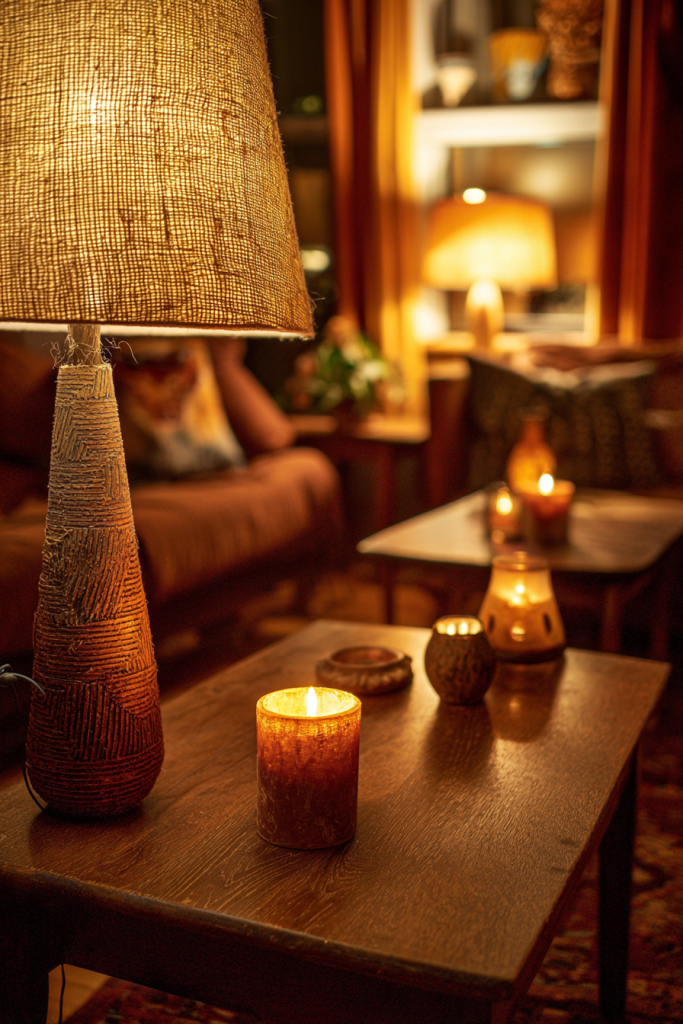
7. Incorporate Earth-Toned Artwork and Prints
Art is where you can really let your earth-tone palette shine while expressing your personal style. I’m drawn to pieces that celebrate natural landscapes—think abstract paintings in rust and ochre, photography of desert scenes, or botanical prints in sage and moss green. Mixed media pieces incorporating natural materials like wood, stone, or dried botanicals add texture and dimension to your walls. Don’t overlook the power of grouping smaller pieces together; a gallery wall of earth-toned prints can create more impact than a single large piece. Frame your artwork in natural wood or warm metal tones that complement rather than compete with the colors in the pieces. Consider supporting local artists whose work reflects your aesthetic—original pieces always add more character than mass-produced prints.
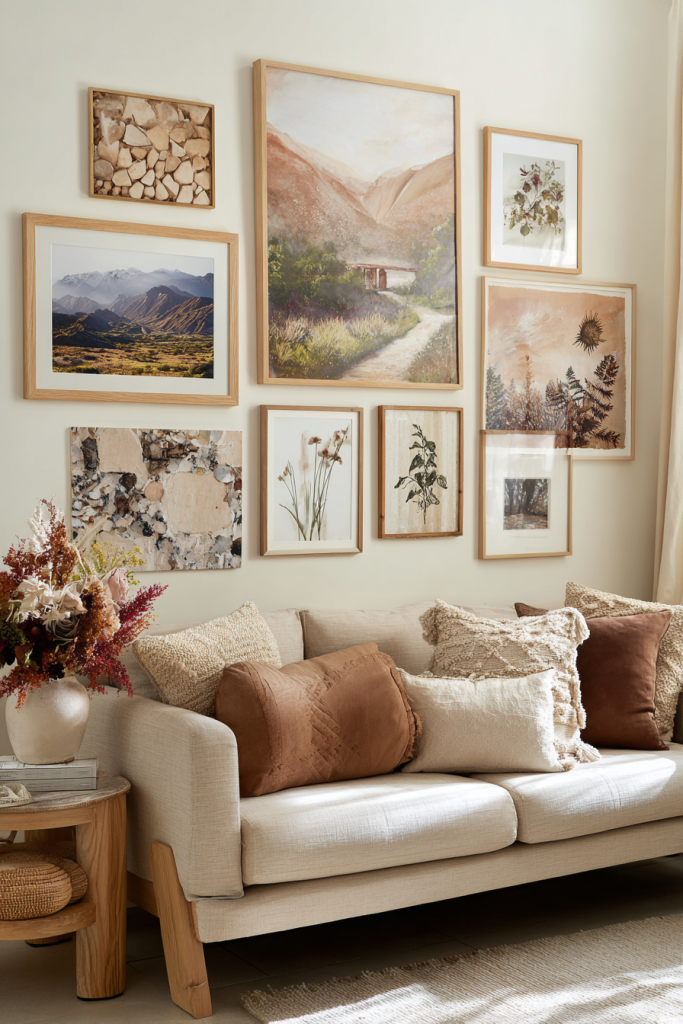
8. Design with Natural Fiber Rugs
A beautiful rug in natural fibers and earth tones can anchor your entire living room design while adding warmth underfoot. I particularly love jute rugs for their durability and natural texture, sisal for its subtle pattern variations, and wool rugs in warm browns or sage greens for their softness and longevity. Consider layering rugs for added interest—a larger neutral jute rug topped with a smaller patterned wool rug in earth tones creates depth and visual appeal. The key is choosing rugs that feel substantial enough to ground your seating area; I typically recommend rugs large enough for at least the front legs of your furniture to rest on them. Natural fiber rugs also age beautifully, developing character and patina that adds to their charm over time.
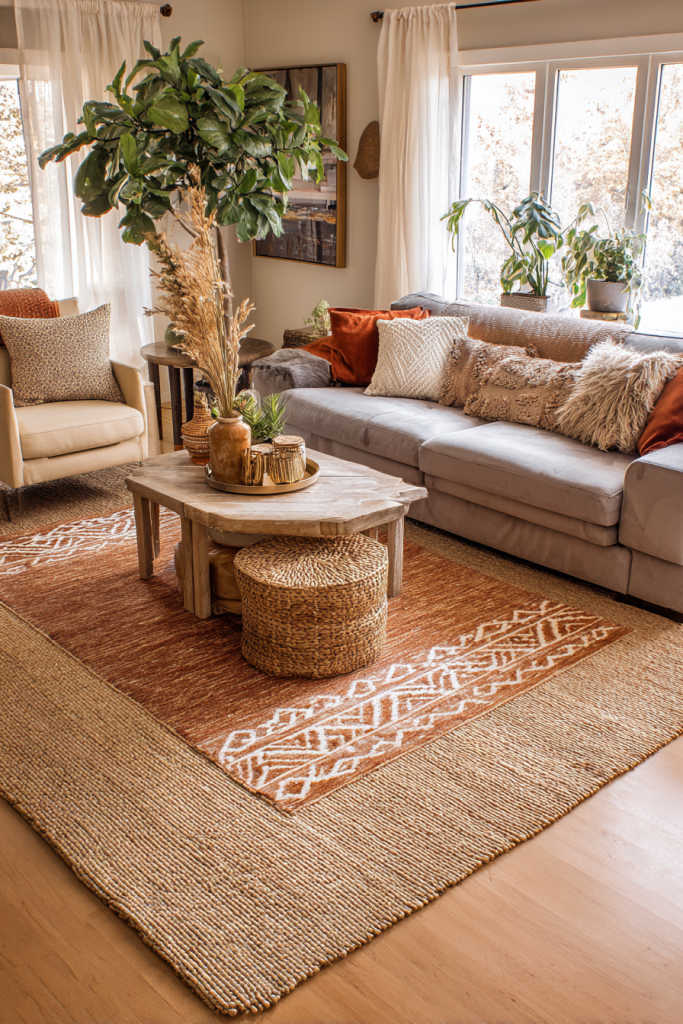
9. Style Shelving with Earth-Toned Accessories
Your shelving and surfaces offer countless opportunities to incorporate earth tones through carefully chosen accessories and decorative objects. I love mixing natural elements like smooth river stones, weathered driftwood, and interesting branches with handcrafted items in warm glazes and natural materials. Books with earth-toned covers, vintage brass candlesticks, and small pottery pieces create visual interest while maintaining your color palette. The key to successful shelf styling is varying heights, textures, and shapes while keeping the color story cohesive. Leave some breathing room between objects—overcrowding diminishes the impact of each piece. Consider the rule of threes when grouping items, and don’t be afraid to edit ruthlessly. Sometimes removing one piece can make the remaining objects shine brighter.
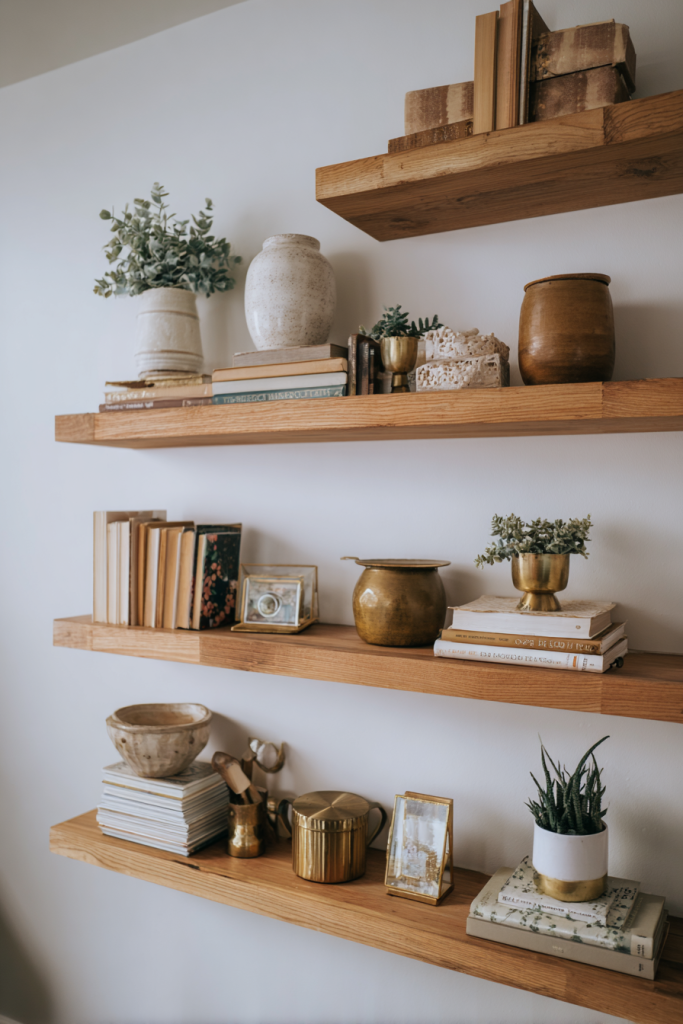
10. Create Cozy Seating Arrangements
The way you arrange your furniture can make your earth-toned living room feel either formal and distant or warm and welcoming. I always advocate for creating conversation areas that bring people together—think chairs angled toward each other, ottomans that can serve as extra seating, and side tables within easy reach of every seat. Choose furniture in natural materials and earth tones when possible, but don’t feel everything needs to match perfectly. A leather sofa in rich cognac paired with a linen armchair in sage green creates more interest than a matching set. Add personal touches like family photos in natural wood frames, throws that invite snuggling, and books that reflect your interests. The goal is creating a space that feels lived-in and authentic rather than showroom-perfect.
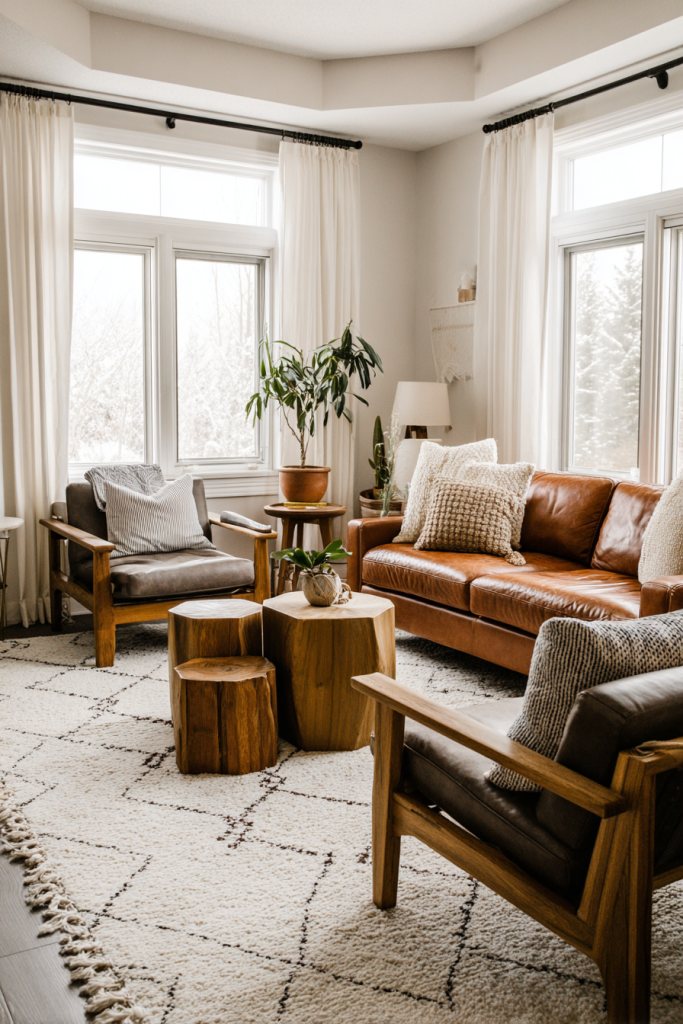
Conclusion
Creating a living room filled with warm earth tones is about more than just choosing the right colors—it’s about crafting a space that feels authentically you while connecting you to the natural world. I’ve found that the most successful earth-toned living rooms feel effortless and collected over time, with each element contributing to an overall sense of warmth and welcome.
Remember that decorating with earth tones is a journey, not a destination. Start with one or two elements that speak to you, whether it’s a beautiful pottery piece, a cozy throw in warm terracotta, or a single accent wall in your favorite sage green. Build your palette gradually, allowing your space to evolve naturally as you discover what brings you joy and comfort.
The beauty of earth tones lies in their timeless appeal and incredible versatility. Whether your style leans rustic, modern, bohemian, or somewhere in between, these natural hues provide a foundation that will serve you well for years to come. Most importantly, trust your instincts and choose pieces that make you smile every time you walk into your living room—that’s the secret to creating a space that truly feels like home.
FAQ
Q: How much does it typically cost to decorate a living room with earth tones? A: Decorating with earth tones can be budget-friendly since many elements like plants, natural accessories, and DIY projects cost very little. You can start with small changes like throw pillows, candles, and artwork for under $200, or invest in larger pieces like furniture and rugs for a more comprehensive makeover ranging from $1,000-$5,000 depending on your space size and quality preferences.
Q: What’s the best way to incorporate earth tones if I’m renting and can’t paint walls? A: Focus on removable elements like large artwork, tapestries, or peel-and-stick wallpaper for visual impact. Use textiles extensively—earth-toned curtains, rugs, throw pillows, and blankets can completely transform your space. Large plants in beautiful planters and substantial furniture pieces in natural materials will also help establish your earth-tone palette without permanent changes.
Q: How do I keep an earth-toned living room from looking boring or too monochromatic? A: The key is mixing textures, patterns, and varying shades within your earth-tone palette. Combine smooth ceramics with rough jute, pair solid colors with subtle patterns, and use different tones of the same color family. Add visual interest through varied heights, interesting shapes, and plenty of natural light. Don’t forget that earth tones include everything from warm creams to deep chocolates—there’s plenty of variety to work with.
Q: Can earth tones work in a small living room, or will they make it feel cramped? A: Earth tones can actually make small spaces feel larger and more cohesive when used thoughtfully. Stick to lighter earth tones like warm beiges, soft sage greens, and cream colors for walls and large furniture pieces. Use darker earth tones as accents through pillows, artwork, and accessories. Ensure you have adequate lighting and incorporate mirrors to reflect natural light and create the illusion of more space.

